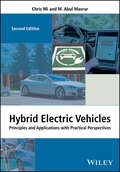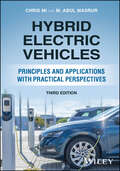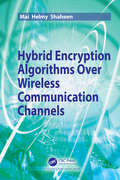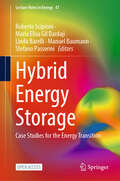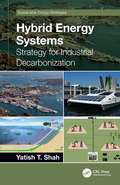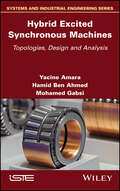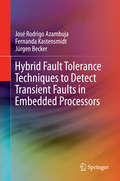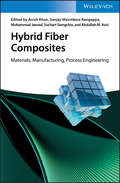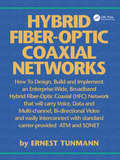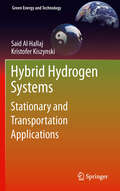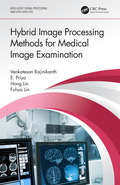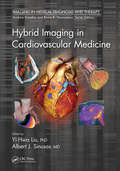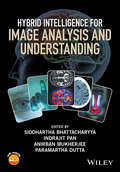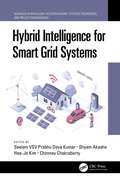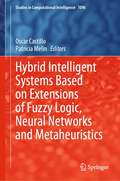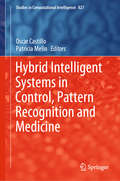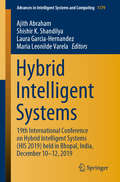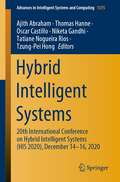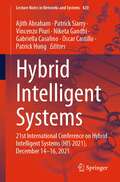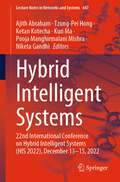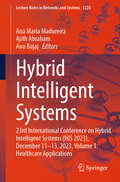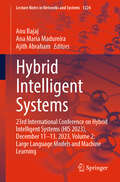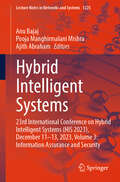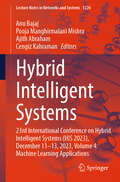- Table View
- List View
Hybrid Electric Vehicles: Principles and Applications with Practical Perspectives
by M. Abul Masrur Chris MiThe latest developments in the field of hybrid electric vehicles Hybrid Electric Vehicles provides an introduction to hybrid vehicles, which include purely electric, hybrid electric, hybrid hydraulic, fuel cell vehicles, plug-in hybrid electric, and off-road hybrid vehicular systems. It focuses on the power and propulsion systems for these vehicles, including issues related to power and energy management. Other topics covered include hybrid vs. pure electric, HEV system architecture (including plug-in & charging control and hydraulic), off-road and other industrial utility vehicles, safety and EMC, storage technologies, vehicular power and energy management, diagnostics and prognostics, and electromechanical vibration issues. Hybrid Electric Vehicles, Second Edition is a comprehensively updated new edition with four new chapters covering recent advances in hybrid vehicle technology. New areas covered include battery modelling, charger design, and wireless charging. Substantial details have also been included on the architecture of hybrid excavators in the chapter related to special hybrid vehicles. Also included is a chapter providing an overview of hybrid vehicle technology, which offers a perspective on the current debate on sustainability and the environmental impact of hybrid and electric vehicle technology. Completely updated with new chapters Covers recent developments, breakthroughs, and technologies, including new drive topologies Explains HEV fundamentals and applications Offers a holistic perspective on vehicle electrification Hybrid Electric Vehicles: Principles and Applications with Practical Perspectives, Second Edition is a great resource for researchers and practitioners in the automotive industry, as well as for graduate students in automotive engineering.
Hybrid Electric Vehicles: Principles and Applications with Practical Perspectives
by M. Abul Masrur Chris MiIntroduction to all types of hybrid electric vehicles (HEVs), with coverage of fundamentals, applications, and the latest industry technologies Hybrid Electric Vehicles: Principles and Applications with Practical Perspectives provides an introduction to hybrid vehicles, from hybrid-electric, hybrid-hydraulic, and plug-in hybrid-electric vehicles to fuel-cell vehicles and off-road hybrid vehicular systems. The book focuses on the propulsion systems for these vehicles, including issues related to power and energy management. Other topics covered include hybrid vs. pure electric, hybrid electric vehicle (HEV) system architecture (including plug-in, charging control, and hydraulic), safety and EMC, storage technologies, vehicular power and energy management, diagnostics and prognostics, and electromechanical vibration issues. This Third Edition has been updated to address the latest industry trends and technologies impacting HEVs, such as more detailed discussions on planetary gear, synchronous reluctance motors, fast-charging methods for batteries, and matters pertaining to cybersecurity in vehicles. The latest HEV industry data and examples highlighting automakers’ current HEV models are featured throughout the book. Topics discussed in Hybrid Electric Vehicles: Principles and Applications with Practical Perspectives include: Specific state-of-the-art HEVs including the Toyota Prius, the Honda Civic, and the Ford Escape, with additional coverage of two-mode hybrid vehiclesHEV fundamentals, covering performance, powertrain component sizing, gradability requirements, and selection of gear ratiosCold start emissions reduction and cold/hot weather performance enhancementElectric and hybrid ships, aircraft, and locomotives, with discussion on industrial utilization of other types of vehiclesMilitary applications of HEVs, covering ruggedness issues, dismounted soldier applications, and electromagnetic launchersFast charging of batteries in electrified vehiclesCybersecurity issues in electrified vehicles Hybrid Electric Vehicles: Principles and Applications with Practical Perspectives is an essential up-to-date reference on the subject for engineers working in the automotive industry, including at automakers, vehicle OEMs, and component suppliers, as well as students and instructors in upper-level undergraduate or graduate courses related to HEVs and electric propulsion.
Hybrid Encryption Algorithms over Wireless Communication Channels
by Mai Helmy ShaheenThis book presents novel hybrid encryption algorithms that possess many different characteristics. In particular, “Hybrid Encryption Algorithms over Wireless Communication Channels”, examines encrypted image and video data for the purpose of secure wireless communications. A study of two different families of encryption schemes are introduced: namely, permutation-based and diffusion-based schemes. The objective of the book is to help the reader selecting the best suited scheme for the transmission of encrypted images and videos over wireless communications channels, with the aid of encryption and decryption quality metrics. This is achieved by applying number-theory based encryption algorithms, such as chaotic theory with different modes of operations, the Advanced Encryption Standard (AES), and the RC6 in a pre-processing step in order to achieve the required permutation and diffusion. The Rubik’s cube is used afterwards in order to maximize the number of permutations. Transmission of images and videos is vital in today’s communications systems. Hence, an effective encryption and modulation schemes are a must. The author adopts Orthogonal Frequency Division Multiplexing (OFDM), as the multicarrier transmission choice for wideband communications. For completeness, the author addresses the sensitivity of the encrypted data to the wireless channel impairments, and the effect of channel equalization on the received images and videos quality. Complete simulation experiments with MATLAB® codes are included. The book will help the reader obtain the required understanding for selecting the suitable encryption method that best fulfills the application requirements.
Hybrid Energy Storage: Case Studies for the Energy Transition (Lecture Notes in Energy #47)
by Linda Barelli Stefano Passerini Manuel Baumann Roberto Scipioni Maria Elisa Gil BardajíThis is an open access book that addresses the need for hybridization in energy storage, offering a fresh perspective on integrating diverse storage solutions to support a successful energy transition. It fills a significant gap in the literature by presenting a comprehensive collection of case studies and real-world examples, while tackling challenges across multiple sectors, including industrial operations, grid, off-grid systems, transportation, and smart building applications. Authored by a multidisciplinary team of leading experts, the book explores technology-neutral requirements for different applications and examines the key drivers behind system installations. It proposes innovative hybrid energy storage solutions grounded in detailed techno-economic and sustainability analyses. Furthermore, by identifying untapped opportunities for electrification and system integration, the book positions itself as a valuable resource for advancing the European Union&’s goals of decarbonization and energy security. By addressing critical hybridization needs, offering a thorough literature review, and presenting application-oriented solutions, it empowers researchers, industry professionals, and policymakers to make informed decisions, while also educating the next generation of scientists and engineers in innovative energy storage approaches.
Hybrid Energy Systems: Strategy for Industrial Decarbonization (Sustainable Energy Strategies)
by Yatish T. ShahHybrid Energy Systems: Strategy for Industrial Decarbonization demonstrates how hybrid energy and processes can decarbonize energy industry needs for power and heating and cooling. It describes the role of hybrid energy and processes in nine major industry sectors and discusses how hybrid energy can offer sustainable solutions in each. Introduces the basics and examples of hybrid energy systems Examines hybrid energy and processes in coal, oil and gas, nuclear, building, vehicle, manufacturing and industrial processes, computing and portable electronic, district heating and cooling, and water sectors Shows that hybrid processes can improve efficiency and that hybrid energy can effectively insert renewable fuels in the energy industry Serves as a companion text to the author’s book Hybrid Power: Generation, Storage, and Grids Written for advanced students, researchers, and industry professionals involved in energy-related processes and plants, this book offers latest research and practical strategies for application of the innovative field of hybrid energy.
Hybrid Excited Synchronous Machines: Topologies, Design and Analysis
by Yacine Amara Mohamed Gabsi Hamid Ben AhmedHybrid Excited Synchronous Machines: Topologies, Design and Analysis
Hybrid Fault Tolerance Techniques to Detect Transient Faults in Embedded Processors
by Jürgen Becker José Rodrigo Azambuja Fernanda KastensmidtThis book describes fault tolerance techniques based on software and hardware to create hybrid techniques. They are able to reduce overall performance degradation and increase error detection when associated with applications implemented in embedded processors. Coverage begins with an extensive discussion of the current state-of-the-art in fault tolerance techniques The authors then discuss the best trade-off between software-based and hardware-based techniques and introduce novel hybrid techniques. Proposed techniques increase existing fault detection rates up to 100%, while maintaining low performance overheads in area and application execution time.
Hybrid Fiber Composites: Materials, Manufacturing, Process Engineering (Engineering Materials Ser.)
by Mohammad Jawaid Anish Khan Suchart Siengchin Sanjay Mavinkere Rangappa AbdullahM. AsiriFiber-reinforced composites are exceptionally versatile materials whose properties can be tuned to exhibit a variety of favorable properties such as high tensile strength and resistance against wear or chemical and thermal influences. Consequently, these materials are widely used in various industrial fields such as the aircraft, marine, and automobile industry. After an overview of the general structures and properties of hybrid fiber composites, the book focuses on the manufacturing and processing of these materials and their mechanical performance, including the elucidation of failure mechanisms. A comprehensive chapter on the modeling of hybrid fiber composites from micromechanical properties to macro-scale material behavior is followed by a review of applications of these materials in structural engineering, packaging, and the automotive and aerospace industries.
Hybrid Fiber-Optic Coaxial Networks: How to Design, Build, and Implement an Enterprise-Wide Broadband HFC Network
by Ernest TunmannThis book covers the planning, design and implementation of hybrid fiber-optic coaxial (HFC) broadband networks in schools, universities, hospitals, factories and offices, whether they are in a single building or multiple campuses. Within the next few yea
Hybrid Hydrogen Systems
by Said Al-Hallaj Kristofer KiszynskiHybrid Hydrogen Systems for Stationary and Transportation Applications presents an original, comprehensive approach to hybrid energy system optimization and provides a much-needed systems approach to hydrogen energy applications. This textbook will be bought by graduate and senior undergraduate students studying renewable energy and the design and optimisation of hydrogen energy systems as well as the lecturers who teach these subjects. Hybrid Hydrogen Systems for Stationary and Transportation Applications will also be bought by researchers and practitioners working with hydrogen and fuel cells as well as policy makers and advocates of renewable energy.
Hybrid Image Processing Methods for Medical Image Examination (Intelligent Signal Processing and Data Analysis)
by Hong Lin Venkatesan Rajinikanth E Priya Fuhua LinIn view of better results expected from examination of medical datasets (images) with hybrid (integration of thresholding and segmentation) image processing methods, this work focuses on implementation of possible hybrid image examination techniques for medical images. It describes various image thresholding and segmentation methods which are essential for the development of such a hybrid processing tool. Further, this book presents the essential details, such as test image preparation, implementation of a chosen thresholding operation, evaluation of threshold image, and implementation of segmentation procedure and its evaluation, supported by pertinent case studies. Aimed at researchers/graduate students in the medical image processing domain, image processing, and computer engineering, this book: Provides broad background on various image thresholding and segmentation techniques Discusses information on various assessment metrics and the confusion matrix Proposes integration of the thresholding technique with the bio-inspired algorithms Explores case studies including MRI, CT, dermoscopy, and ultrasound images Includes separate chapters on machine learning and deep learning for medical image processing
Hybrid Imaging in Cardiovascular Medicine (Imaging in Medical Diagnosis and Therapy)
by Yi-Hwa Liu Albert J. SinusasThis comprehensive book focuses on multimodality imaging technology, including overviews of the instruments and methods followed by practical case studies that highlight use in the detection and treatment of cardiovascular diseases. Chapters cover PET-CT, SPECT-CT, SPECT-MRI, PET-MRI, PET-optical imaging, SPECT-optical imaging, photoacoustic Imaging, and hybrid intravascular imaging. It also addresses the important issues of multimodality imaging probes and image quantification. <P><P>Readers from radiology and cardiology as well as medical imaging and biomedical engineering will learn essentials of the field. They will be shown how the field has advanced quantitative analysis of molecularly targeted imaging through improvements in the reliability and reproducibility of imaging data. Moreover, they will be presented with quantification algorithms and case illustrations, including coverage of such topics such as multimodality image fusion and kinetic modeling. <P><P>Yi-Hwa Liu, PhD is Senior Research Scientist in Cardiovascular Medicine at Yale University School of Medicine and Technical Director of Nuclear Cardiology at Yale New Haven Hospital. He is also an Associate Professor (Adjunct) of Biomedical Imaging and Radiological Sciences at National Yang-Ming University, Taipei, Taiwan, and Professor (Adjunct) of Biomedical Engineering at Chung Yuan Christian University, Taoyuan, Taiwan. He is an elected senior member of Institute of Electrical and Electronic Engineers (IEEE) and a full member of Sigma Xi of The Scientific Research Society of North America. <P><P>Albert J. Sinusas, M.D., FACC, FAHA is Professor of Medicine (Section of Cardiovascular Medicine) and Radiology and Biomedical Imaging, at Yale University School of Medicine, and Director of the Yale Translational Research Imaging Center (Y-TRIC), and Director of Advanced Cardiovascular Imaging at Yale New Haven Hospital. He is a recipient of the Society of Nuclear Medicine’s Hermann Blumgart Award.
Hybrid Intelligence for Image Analysis and Understanding
by Siddhartha Bhattacharyya Paramartha Dutta Anirban Mukherjee Indrajit PanA synergy of techniques on hybrid intelligence for real-life image analysis Hybrid Intelligence for Image Analysis and Understanding brings together research on the latest results and progress in the development of hybrid intelligent techniques for faithful image analysis and understanding. As such, the focus is on the methods of computational intelligence, with an emphasis on hybrid intelligent methods applied to image analysis and understanding. The book offers a diverse range of hybrid intelligence techniques under the umbrellas of image thresholding, image segmentation, image analysis and video analysis. Key features: Provides in-depth analysis of hybrid intelligent paradigms. Divided into self-contained chapters. Provides ample case studies, illustrations and photographs of real-life examples to illustrate findings and applications of different hybrid intelligent paradigms. Offers new solutions to recent problems in computer science, specifically in the application of hybrid intelligent techniques for image analysis and understanding, using well-known contemporary algorithms. The book is essential reading for lecturers, researchers and graduate students in electrical engineering and computer science.
Hybrid Intelligence for Smart Grid Systems (Advances in Intelligent Decision-Making, Systems Engineering, and Project Management)
by Seelam VSV Prabhu Deva KumarThis book provides an overview of distributed control and distributed optimization theory, followed by specific details on industrial applications to smart grid systems. It discusses the fundamental analysis and design schemes for developing actual working smart grids and covers all aspects concerning the conventional and nonconventional methods of their use. Hybrid Intelligence for Smart Grid Systems provides an overview of a smart grid, along with its needs, benefits, challenges, and existing structure and describes the inverter topologies adopted for integrating renewable power, and provides an overview of its needs, benefits, challenges, and possible future technologies. This pioneering book is a must-read for researchers, engineering professionals, and students, giving them the tools needed to move from the concept of a smart grid to its actual design and implementation. Moreover, it will enable regulators, policymakers, and energy executives to understand the future of energy delivery systems towards safe, economical, high-quality power delivery in a dynamic and demanding environment.
Hybrid Intelligence: Proceedings of the 4th International Conference on Computational Design and Robotic Fabrication (CDRF 2022) (Computational Design and Robotic Fabrication)
by Philip F. Yuan Chao Yan Hua Chai Keke Li Tongyue SunThis open access book is a compilation of selected papers from DigitalFUTURES 2022—The 4th International Conference on Computational Design and Robotic Fabrication (CDRF 2022). The work focuses on novel techniques for computational design and robotic fabrication. The contents make valuable contributions to academic researchers, designers, and engineers in the industry. As well, readers encounter new ideas about intelligence in architecture.
Hybrid Intelligent Systems Based on Extensions of Fuzzy Logic, Neural Networks and Metaheuristics (Studies in Computational Intelligence #1096)
by Oscar Castillo Patricia MelinIn this book, recent theoretical developments on fuzzy logic, neural networks and optimization algorithms, as well as their hybrid combinations, are presented. In addition, the above-mentioned methods are presented in application areas such as, intelligent control and robotics, pattern recognition, medical diagnosis, decision-making, time series prediction and optimization of complex problems. The book contains a collection of papers focused on hybrid intelligent systems based on soft computing techniques. There are a group of papers with the main theme of type-1 and type-2 fuzzy logic, which basically consists of papers that propose new concepts and algorithms based on type-1 and type-2 fuzzy logic and their applications. There also a group of papers that offer theoretical concepts and applications of meta-heuristics in different areas. Another group of papers outlines diverse applications of fuzzy logic, neural networks and hybrid intelligent systems in medical problems. There are also some papers that present theory and practice of neural networks in different application areas. In addition, there are papers that offer theory and practice of optimization and evolutionary algorithms in different application areas. Finally, there are a group of papers describing applications of fuzzy logic, neural networks and meta-heuristics in pattern recognition and classification problems.
Hybrid Intelligent Systems in Control, Pattern Recognition and Medicine (Studies in Computational Intelligence #827)
by Oscar Castillo Patricia MelinThis book describes the latest advances in fuzzy logic, neural networks and optimization algorithms, as well as their hybrid combinations, and their applications in areas such as: intelligent control and robotics, pattern recognition, medical diagnosis, time series prediction, and optimization of complex problems. The book is divided into five main parts. The first part proposes new concepts and algorithms based on type-1 and type-2 fuzzy logic and their applications; the second explores new concepts and algorithms in neural networks and fuzzy logic applied to recognition. The third part examines the theory and practice of meta-heuristics in various areas of application, while the fourth highlights diverse applications of fuzzy logic, neural networks and hybrid intelligent systems in medical contexts. Finally, the fifth part focuses on applications of fuzzy logic, neural networks and meta-heuristics to robotics problems.
Hybrid Intelligent Systems: 19th International Conference on Hybrid Intelligent Systems (HIS 2019) held in Bhopal, India, December 10-12, 2019 (Advances in Intelligent Systems and Computing #1179)
by Ajith Abraham Maria Leonilde Varela Shishir K. Shandilya Laura Garcia-HernandezThis book highlights the recent research on hybrid intelligent systems and their various practical applications. It presents 34 selected papers from the 18th International Conference on Hybrid Intelligent Systems (HIS 2019) and 9 papers from the 15th International Conference on Information Assurance and Security (IAS 2019), which was held at VIT Bhopal University, India, from December 10 to 12, 2019. A premier conference in the field of artificial intelligence, HIS - IAS 2019 brought together researchers, engineers and practitioners whose work involves intelligent systems, network security and their applications in industry. Including contributions by authors from 20 countries, the book offers a valuable reference guide for all researchers, students and practitioners in the fields of Computer Science and Engineering.
Hybrid Intelligent Systems: 20th International Conference on Hybrid Intelligent Systems (HIS 2020), December 14-16, 2020 (Advances in Intelligent Systems and Computing #1375)
by Ajith Abraham Oscar Castillo Thomas Hanne Tzung-Pei Hong Niketa Gandhi Tatiane Nogueira RiosThis book highlights the recent research on hybrid intelligent systems and their various practical applications. It presents 58 selected papers from the 20th International Conference on Hybrid Intelligent Systems (HIS 2020) and 20 papers from the 12th World Congress on Nature and Biologically Inspired Computing (NaBIC 2020), which was held online, from December 14 to 16, 2020. A premier conference in the field of artificial intelligence, HIS - NaBIC 2020 brought together researchers, engineers and practitioners whose work involves intelligent systems, network security and their applications in industry. Including contributions by authors from 25 countries, the book offers a valuable reference guide for all researchers, students and practitioners in the fields of science and engineering.
Hybrid Intelligent Systems: 21st International Conference on Hybrid Intelligent Systems (HIS 2021), December 14–16, 2021 (Lecture Notes in Networks and Systems #420)
by Ajith Abraham Oscar Castillo Vincenzo Piuri Patrick Siarry Niketa Gandhi Gabriella Casalino Patrick HungThis book highlights the recent research on hybrid intelligent systems and their various practical applications. It presents 45 selected papers from the 20th International Conference on Hybrid Intelligent Systems (HIS 2021) and 16 papers from the 17th International Conference on Information Assurance and Security, which was held online, from December 14 to 16, 2021. A premier conference in the field of artificial intelligence and machine learning applications, HIS-IAS 2021 brought together researchers, engineers and practitioners whose work involves intelligent systems, network security and their applications in industry. Including contributions by authors from over 20 countries, the book offers a valuable reference guide for all researchers, students and practitioners in the fields of computer science and engineering.
Hybrid Intelligent Systems: 22nd International Conference on Hybrid Intelligent Systems (HIS 2022), December 13–15, 2022 (Lecture Notes in Networks and Systems #647)
by Ajith Abraham Tzung-Pei Hong Kun Ma Niketa Gandhi Ketan Kotecha Pooja Manghirmalani MishraThis book highlights the recent research on hybrid intelligent systems and their various practical applications. It presents 97 selected papers from the 22nd International Conference on Hybrid Intelligent Systems (HIS 2022) and 26 papers from the 18th International Conference on Information Assurance and Security, which was held online, from 13 to 15 December 2022. A premier conference in the field of artificial intelligence and machine learning applications, HIS–IAS 2022, brought together researchers, engineers and practitioners whose work involves intelligent systems, network security and their applications in industry. Including contributions by authors from over 35 countries, the book offers a valuable reference guide for all researchers, students and practitioners in the fields of Computer Science and Engineering.
Hybrid Intelligent Systems: 23rd International Conference on Hybrid Intelligent Systems (HIS 2023), December 11-13, 2023, Volume 1: Healthcare Applications (Lecture Notes in Networks and Systems #1223)
by Ajith Abraham Ana Maria Madureira Anu BajajThis book presents 48 selected papers focused on Health Care Applications from the 23rd International Conference on Hybrid Intelligent Systems, which was held in five different cities namely Olten, Switzerland; Porto, Portugal; Kaunas, Lithuania; Greater Noida, India; Kochi, India and in online mode. The 23rd International Conference on Hybrid Intelligent Systems (HIS 2023) was focusing on synergistic combinations of multiple approaches to develop the next generation of intelligent systems. HIS 2023 had contributions by authors from 44 countries. This book offers a valuable reference guide for all medical doctors, scientists, academicians, researchers, students, and practitioners in the field of artificial intelligence and smart health care.
Hybrid Intelligent Systems: 23rd International Conference on Hybrid Intelligent Systems (HIS 2023), December 11-13, 2023, Volume 2: Large Language Models and Machine Learning (Lecture Notes in Networks and Systems #1224)
by Ajith Abraham Ana Maria Madureira Anu BajajThis book presents 48 selected papers focused on Large Language Models and Machine Learning from the 23rd International Conference on Hybrid Intelligent Systems, which was held in five different cities namely Olten, Switzerland; Porto, Portugal; Kaunas, Lithuania; Greater Noida, India; Kochi, India and in online mode. The 23rd International Conference on Hybrid Intelligent Systems (HIS 2023) was focusing on synergistic combinations of multiple approaches to develop the next generation of intelligent systems. HIS 2023 had contributions by authors from 44 countries. This book offers a valuable reference guide for all scientists, academicians, researchers, students, and practitioners in the field of artificial intelligence and deep learning.
Hybrid Intelligent Systems: 23rd International Conference on Hybrid Intelligent Systems (HIS 2023), December 11-13, 2023, Volume 3: Information Assurance and Security (Lecture Notes in Networks and Systems #1225)
by Ajith Abraham Pooja Manghirmalani Mishra Anu BajajThis book presents 48 selected papers focused on Information and Network Security from the 23rd International Conference on Hybrid Intelligent Systems and 19th International Conference on Information Assurance and Security (IAS 2023), which was held in five different cities namely Olten, Switzerland; Porto, Portugal; Kaunas, Lithuania; Greater Noida, India; Kochi, India and in online mode. The 23rd International Conference on Hybrid Intelligent Systems (HIS 2023) was focusing on synergistic combinations of multiple approaches to develop the next generation of intelligent systems. HIS-IAS 2023 had contributions by authors from 44 countries. This book offers a valuable reference guide for all network and security specialists, scientists, academicians, researchers, students, and practitioners in the field of artificial intelligence and information/network security.
Hybrid Intelligent Systems: 23rd International Conference on Hybrid Intelligent Systems (HIS 2023), December 11-13, 2023, Volume 4: Machine Learning Applications (Lecture Notes in Networks and Systems #1226)
by Ajith Abraham Cengiz Kahraman Pooja Manghirmalani Mishra Anu BajajThis book presents 48 selected papers focused on Machine Learning Based Solutions from the 23rd International Conference on Hybrid Intelligent Systems, which was held in five different cities namely Olten, Switzerland; Porto, Portugal; Kaunas, Lithuania; Greater Noida, India; Kochi, India and in online mode. The 23rd International Conference on Hybrid Intelligent Systems (HIS 2023) was focusing on synergistic combinations of multiple approaches to develop the next generation of intelligent systems. HIS 2023 had contributions by authors from 44 countries. This book offers a valuable reference guide for all industrial specialists, scientists, academicians, researchers, students, and practitioners in the field of machine learning and industrial applications.
